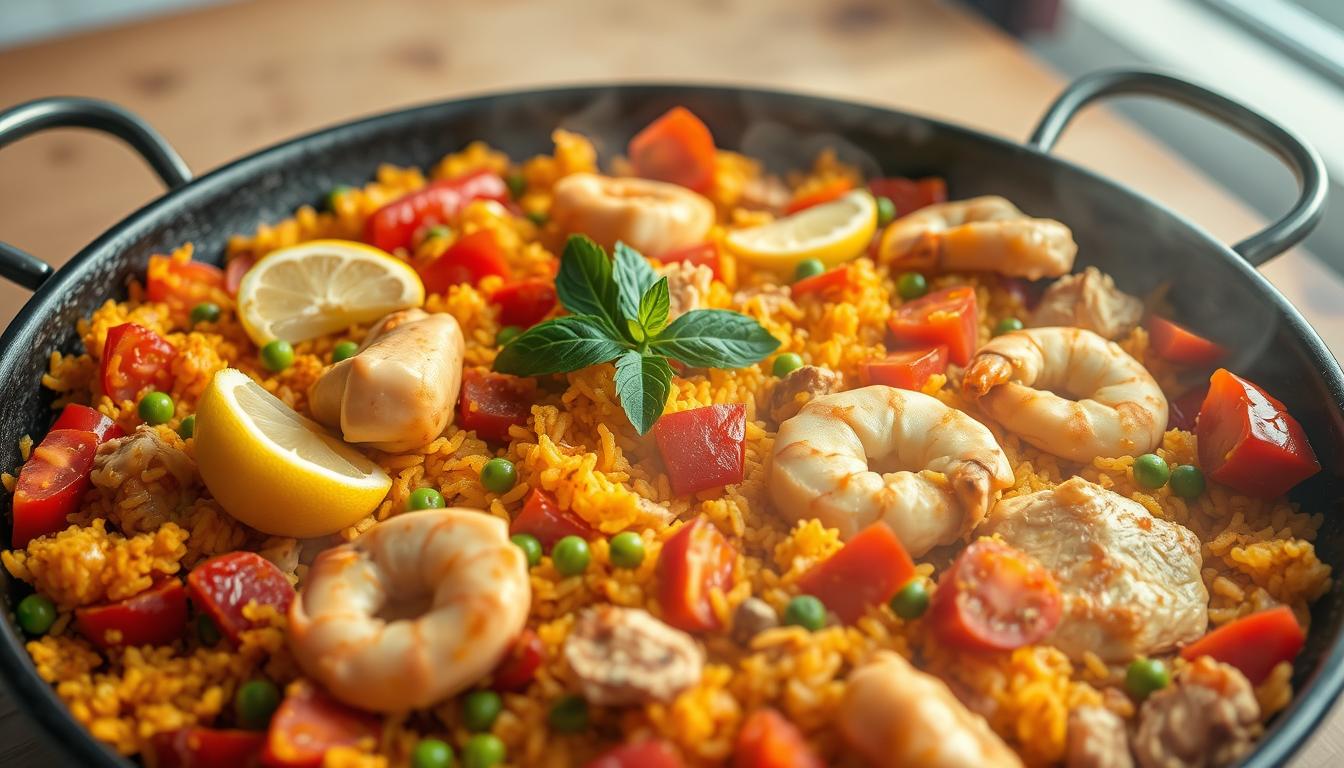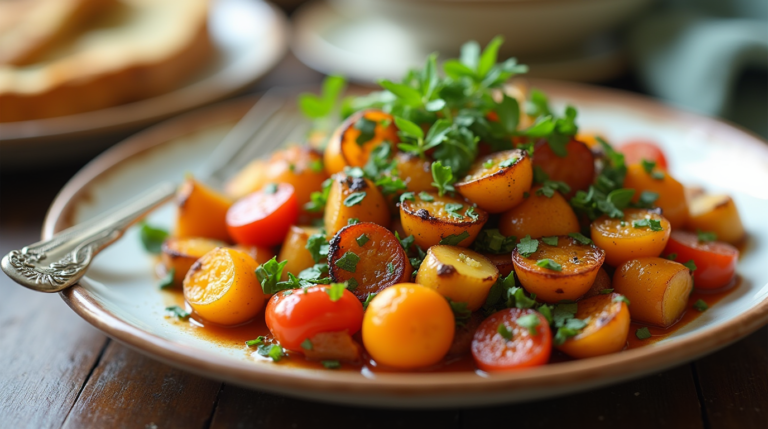Paella Recipe: Savor the Taste of Spain in Your Kitchen
Ever wondered how a single Spanish rice dish could capture the essence of the Mediterranean? Paella is more than a meal; it’s a journey that turns your kitchen into a lively Spanish feast.
This dish comes from Valencia’s sunny coast. It brings real Spanish tastes right to your table. Our 60-minute guide will show you how to make a delicious Spanish rice dish. It will take your taste buds straight to Spain.
Whether you love cooking or just want to try something new, this paella recipe is for you. It’s a colorful, aromatic dish that will wow your guests. It’s a story of culture, tradition, and amazing flavors.
Key Takeaways
- Learn an authentic paella recipe from Valencia
- Master the art of Spanish rice dish preparation
- Discover traditional cooking techniques
- Create a restaurant-quality meal at home
- Explore the rich culinary heritage of Spain
The Rich Heritage of Spanish Paella: From Valencia to Your Table
Paella is more than a meal; it’s a journey through Spanish history. It comes from Valencia’s rice fields, where it tells stories of tradition and pride.
Origins in Valencia's Rice Fields
Paella was born in Valencia’s rich land, where rice has been key for ages. It was made by farmers and workers as a filling meal with local stuff.
- First prepared by farm workers in the mid-19th century
- Cooked over an open fire using ingredients from surrounding fields
- Originally made with rabbit, snails, and local vegetables
Traditional Significance in Spanish Culture
Paella is more than rice; it’s about community and shared moments. People come together, making memories with every bite of seafood rice.
“Paella is not just food, it’s a celebration of life and togetherness” – Spanish Culinary Tradition
Evolution of Regional Variations
Paella spread across Spain, leading to many versions. Each region made it their own, changing the original recipe.
| Region | Paella Variation | Key Ingredients |
|---|---|---|
| Valencia | Traditional Paella | Rabbit, snails, beans |
| Coastal Regions | Seafood Paella | Shrimp, mussels, calamari |
| Inland Areas | Mixed Paella | Chicken, vegetables, chorizo |
Each version shows off local tastes and creativity. It proves how versatile this saffron rice dish can be.
Essential Ingredients for Authentic Paella Recipe
Making an authentic paella starts with picking the right ingredients. Your journey in the kitchen begins with choosing top-quality parts. These parts bring the true taste of Spanish food to your home.
The core of a great paella is the rice. Bomba rice is the top pick for a real dish. This special rice soaks up flavors well and keeps its texture just right. When you make chicken and rice paella, bomba rice makes sure every grain tastes rich and complex.
- Bomba Rice: The gold standard for authentic paella
- High-quality extra virgin olive oil
- Fresh proteins (chicken, seafood, or both)
- Aromatic saffron threads
- Fresh vegetables like bell peppers and tomatoes
The protein you choose can change the whole feel of the paella. A mix of chicken and rice is classic, while seafood adds a sea flavor. The most important thing is to use the freshest ingredients you can find.
“The quality of your ingredients determines the soul of your paella.” – Spanish Cooking Wisdom
Don’t forget these key parts:
- Saffron: The golden spice that gives paella its distinctive color
- Fresh garlic and onions for depth of flavor
- High-quality broth to cook the bomba rice
By choosing each ingredient with care, you’ll make a paella that feels like a trip to Spain’s coast.
Choosing the Perfect Rice: Bomba vs. Calasparra
Choosing the right rice is key to making a great paella. Calasparra rice or other types can change the dish’s texture and taste. Knowing the differences in rice types can make your paella go from good to amazing.
Characteristics of Bomba Rice
Bomba rice is a top pick for paella lovers. It’s a short-grain rice from Spain that soaks up a lot of liquid. It keeps its firm texture and holds flavors well.
- Absorbs up to three times its volume in liquid
- Maintains firm texture during cooking
- Exceptional at holding flavor without becoming mushy
- Ideal for creating authentic Spanish rice dishes
Why Calasparra Rice Works Best
Calasparra rice, from Murcia, Spain, is a favorite for paella. It’s known for its creamy yet firm texture and great flavor retention.
| Characteristic | Description |
|---|---|
| Origin | Protected Designation of Origin from Murcia, Spain |
| Texture | Creamy yet firm, with excellent flavor retention |
| Cooking Performance | Maintains individual grain structure |
Alternative Rice Options
If Bomba and Calasparra rice are hard to find, don’t worry. You can still make tasty paella with these alternatives:
- Arborio rice
- Short-grain Japanese rice
- Valencia rice
Pro tip: Always choose short-grain rice varieties for the most authentic paella experience.
The Magic of Saffron: Golden Secret to Perfect Paella
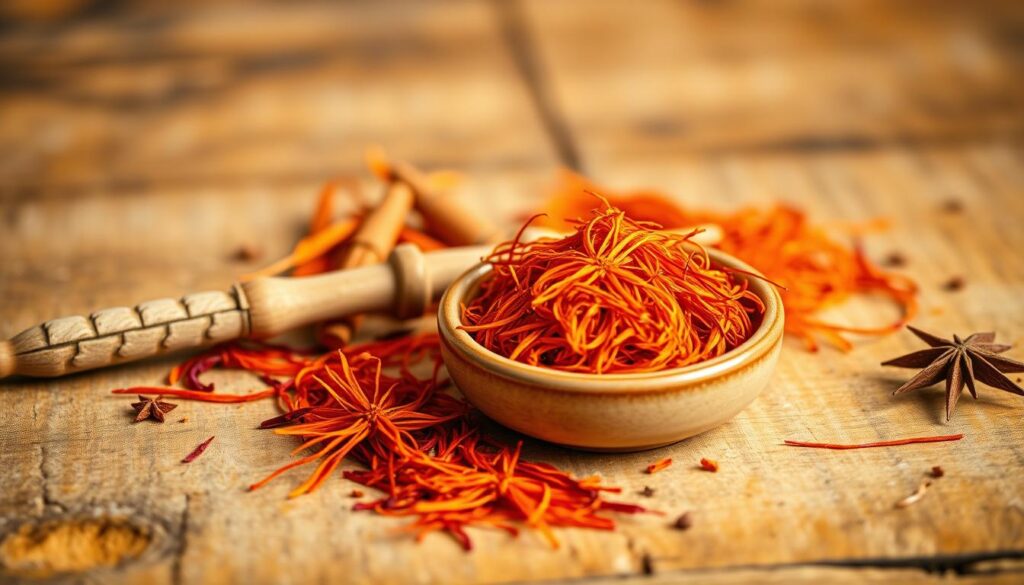
Saffron turns a simple paella recipe into a work of art. This special spice adds a golden color and a unique taste that makes Spanish saffron rice stand out. The vibrant saffron threads are more than just pretty – they’re the essence of a great paella.
To understand saffron’s magic, we must know where it comes from and what it’s like. It’s made from crocus flowers, picked by hand with great care. Its deep flavor and color come from how it’s processed, making it very expensive.
- Saffron adds a rich golden hue to paella
- Provides a subtle, slightly sweet flavor profile
- Transforms standard rice into an extraordinary paella recipe
To get the most out of saffron, you need to use the right method. Gently toast or bloom the saffron threads in warm liquid before adding it to your paella. This step releases the spice’s flavors and ensures even color and taste.
| Saffron Quality | Characteristic | Impact on Paella |
|---|---|---|
| High-Grade Saffron | Deep red threads | Intense color and flavor |
| Medium-Grade Saffron | Mixed color threads | Moderate flavor profile |
| Low-Grade Saffron | Pale yellow threads | Minimal flavor impact |
Pro tip: Keep your saffron in a sealed container, away from light and heat. Even a small amount can make your saffron rice taste like it’s from Spain.
Mastering the Sofrito Base
The heart of any authentic Spanish rice dish is its sofrito base. This technique turns simple ingredients into a flavor-packed cornerstone of traditional paella. It’s key for home cooks wanting to make Spanish cuisine magic.
Making a perfect sofrito takes patience and detail. This slow-cooked mix is the flavor foundation that makes your paella special.
Traditional Sofrito Ingredients
- Ripe tomatoes, finely chopped
- Sweet Spanish onions
- Fresh garlic cloves
- Extra virgin olive oil
- Optional: Red bell peppers
Proper Cooking Technique
To make a great sofrito base, start with a gentle touch. Heat olive oil in a wide pan, then add diced onions. Cook them slowly until they’re translucent and golden. This can take up to 15 minutes, releasing deep flavors.
Impact on Final Flavor
The sofrito is more than a first step in your Spanish rice dish. It adds a rich, concentrated flavor that can’t be matched by raw ingredients. Each ingredient caramelizes, blending together to become the soul of your paella.
Pro tip: Take your time with the sofrito. The slower you cook, the more incredible your flavor will be!
Essential Kitchen Tools and the Perfect Paellera Pan
Making a real paella recipe starts with the right cooking tools. The paellera pan is key, turning simple ingredients into a stunning Spanish dish.
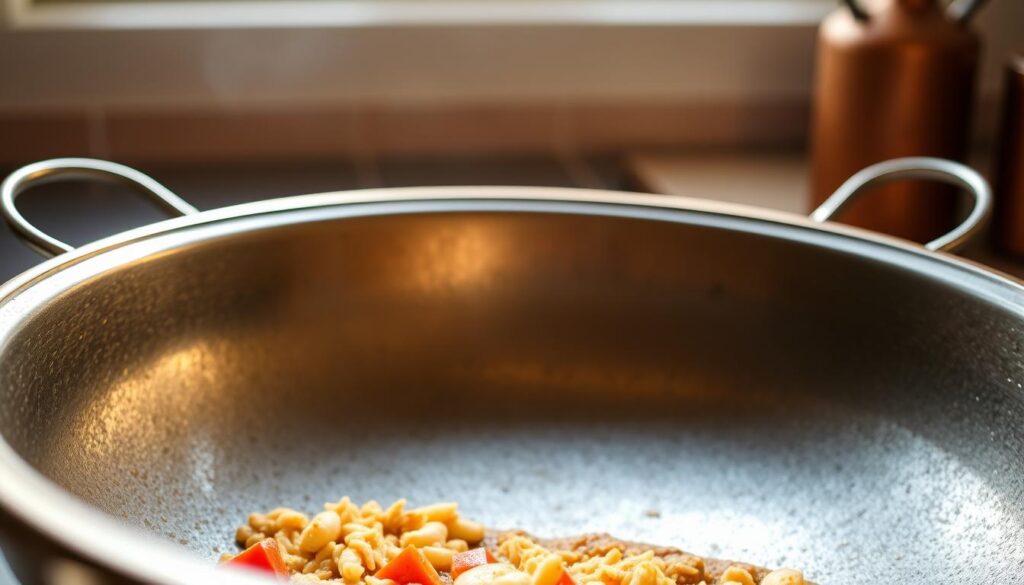
Your paellera pan is more than a cooking tool. It’s essential for a perfect paella. Its wide, shallow shape spreads heat evenly. This helps make the crispy rice layer, or socarrat, that makes paella famous.
Key Features of an Ideal Paellera Pan
- Typically made of carbon steel
- Wide and shallow design
- Diameter ranging from 13-16 inches
- Thin material for rapid heat conductivity
When picking a paellera pan, look for these key traits. The pan’s shape cooks rice evenly. It also helps create that crispy bottom everyone loves.
Alternative Cooking Tools
Not everyone has a traditional paellera pan. But, you can still make great paella with:
- Large cast-iron skillet
- Wide stainless steel pan
- Non-stick large diameter pan
“The right pan is half the battle in creating an authentic paella.” – Spanish Culinary Masters
| Pan Type | Heat Conductivity | Socarrat Potential |
|---|---|---|
| Traditional Paellera | Excellent | High |
| Cast Iron Skillet | Very Good | Good |
| Stainless Steel Pan | Good | Moderate |
Invest in quality tools, and your paella recipe will thank you. It will taste amazing and have that true Spanish flavor.
Step-by-Step Paella Recipe: A Complete Guide
Making a true Spanish rice dish needs care, love, and practice. Your paella journey starts with knowing the right mix of ingredients and techniques. These steps turn simple parts into a true work of art.
Ingredient Preparation Phase
First, collect your ingredients and prepare them well. A great paella recipe needs a good start:
- Chop vegetables evenly
- Clean and season seafood or meat
- Measure rice and broth carefully
- Have saffron and spices ready
Masterful Cooking Technique
The cooking method is key to a real Spanish rice dish. Begin by heating your paellera pan. Then, make a flavorful sofrito base by sautéing onions and garlic until they’re soft.
- Add rice, stirring to coat with oils
- Pour warm broth gradually
- Distribute proteins evenly
- Maintain consistent medium heat
Finishing With Finesse
The last steps of your paella recipe are very important. Listen for the crackling sound that means socarrat is forming. This crispy bottom is what makes a dish special. After cooking, let it rest and add fresh herbs.
Pro tip: Don’t stir during the final cooking stage to get that perfect crispy rice layer!
Seafood Selection and Preparation Tips
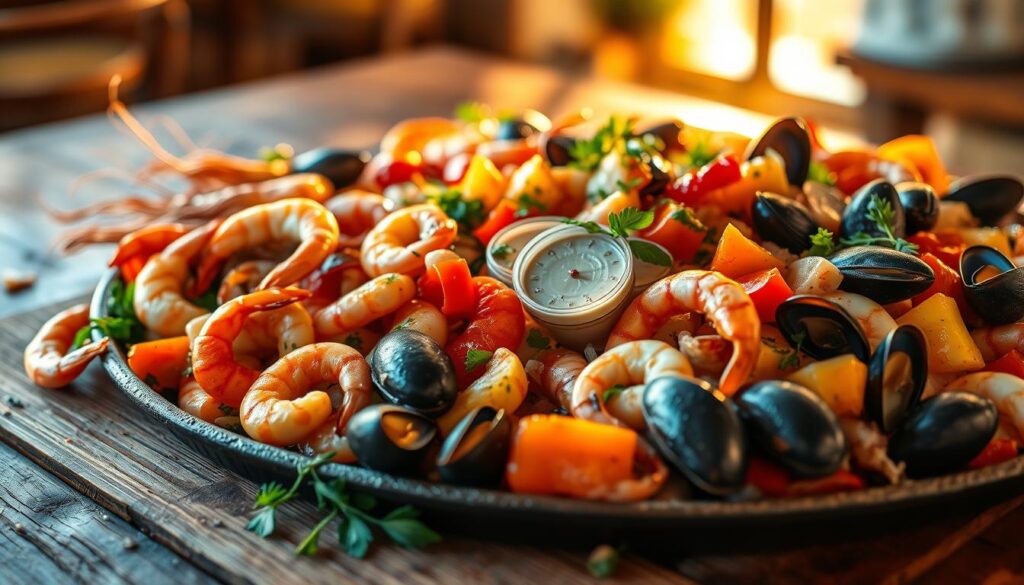
Creating the perfect seafood rice dish starts with the right seafood. Not all seafood is the same. Choosing the freshest ingredients can make your meal amazing.
When preparing a seafood paella, consider these top seafood options:
- Shrimp: Sweet and tender, best added towards the end of cooking
- Mussels: Bring a briny flavor and dramatic presentation
- Clams: Add a delicate oceanic touch to your seafood rice
- Squid: Provides a unique texture and authentic Spanish coastal flavor
Your seafood paella recipe needs careful timing and preparation. Always clean seafood well and remove any shells or unwanted parts. Fresh seafood makes a big difference in taste.
Pro tips for selecting the best seafood:
- Choose seafood that’s firm and has a clean, ocean-like smell
- Buy from reputable fishmongers or seafood markets
- Keep seafood refrigerated until ready to cook
- Add delicate seafood like shrimp in the last 5-7 minutes of cooking
A successful seafood rice dish demands attention to detail. Know each seafood’s cooking time. This prevents overcooking and keeps your paella perfect.
Achieving the Perfect Socarrat: The Crispy Bottom Layer
The socarrat is the key to a great paella. This golden-brown crispy rice layer turns a simple Spanish rice dish into a masterpiece. It takes you straight to Valencia with every bite.
Making the perfect socarrat needs precision and patience. It’s not just about cooking rice. It’s about finding the right heat and timing to make it crispy.
Mastering Temperature Control
Temperature is key for socarrat. Here are some important tips:
- Start with medium-high heat during initial cooking
- Lower heat during primary rice preparation
- Increase heat gradually during final minutes
- Listen for a subtle crackling sound
Timing Guidelines for Crispy Perfection
The timing for socarrat is tight but doable. Here’s what you should aim for:
| Cooking Stage | Duration | Heat Level |
|---|---|---|
| Initial Rice Cooking | 15-18 minutes | Medium |
| Socarrat Development | 3-5 minutes | High |
| Final Resting | 5-7 minutes | No Heat |
“The secret to socarrat is patience and attention – never walk away from your paella!” – Spanish Culinary Experts
Pro tip: Look for a nutty smell and a slight crackling sound. These signs mean your socarrat is perfect. With practice, you’ll get it right every time.
Wine Pairing and Serving Suggestions
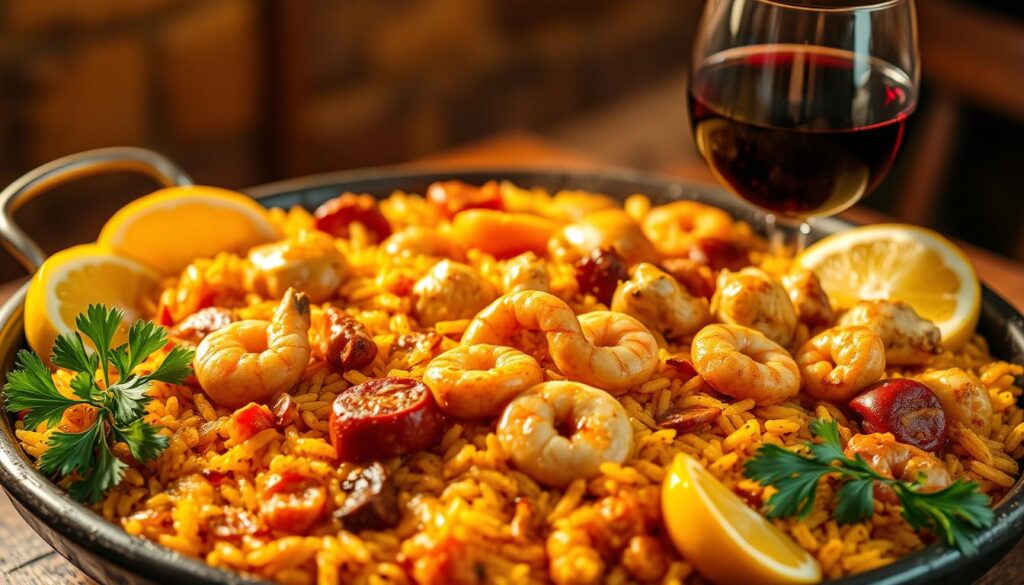
Improving your paella recipe is more than just cooking. The way you serve it can make a big difference. In Spain, serving paella is all about sharing and creating special moments.
Here are some tips for serving your paella:
- Serve the paella directly in the paellera (traditional cooking pan)
- Place the pan at the center of the table for a shared dining experience
- Allow guests to serve themselves directly from the pan
Choosing the right wine can really enhance your Spanish rice dish. Pick wines that match the flavors of your paella:
- Albariño: A crisp white wine from Galicia perfect for seafood paella
- Tempranillo: A medium-bodied red that pairs beautifully with meat-based paellas
- Cava: A sparkling Spanish wine that adds festivity to your meal
If you prefer not to serve wine, try sparkling water with lemon or a Spanish sangria mocktail. The goal is to make your meal lively and fun, celebrating the tradition of your paella recipe.
Common Mistakes to Avoid When Making Paella
Making the perfect paella can be tough, even for experts. Knowing common mistakes helps you make a delicious Spanish dish. It will impress your guests and satisfy your taste buds.
Rice-to-Liquid Ratio Challenges
The right rice-to-liquid ratio is key. Too much liquid makes rice mushy, too little makes it hard. Here’s how to get it right:
- Use precise measurements for rice and broth
- Choose high-quality short-grain rice like Bomba
- Measure liquid carefully to maintain perfect texture
Temperature Management Mistakes
Controlling heat is crucial. Bad heat can ruin your paella’s flavors and texture.
| Temperature Issue | Potential Result | Solution |
|---|---|---|
| Too High Heat | Burnt Bottom | Use medium-low consistent heat |
| Uneven Flame | Inconsistent Cooking | Rotate pan periodically |
| Low Heat | Soggy Rice | Maintain steady medium heat |
Ingredient Selection Errors
Choosing the right ingredients is vital. Fresh, authentic ingredients are essential for a true Spanish dish.
- Use fresh seafood
- Select authentic Spanish rice varieties
- Choose high-quality saffron
- Avoid frozen or pre-cooked ingredients
Paella is a learning journey. With practice and attention to these tips, you’ll become a pro at making a great Spanish rice dish.
Conclusion
Your journey to learn the ultimate Spanish rice dish is over. You now know the rich cultural background and how to make a real paella. This will take your taste buds straight to Spain’s lively food scene.
The paella recipe you’ve learned is more than cooking. It’s a way to celebrate tradition and show off your creativity. Every paella you make lets you connect with Spanish cooking and share your own style. You can make it with seafood or stick to the classic Valencian way.
Mastering paella takes time and practice. Don’t worry about the complex steps or what others expect. Enjoy learning, try new things, and make a dish that brings people together. Your paella will be more than food—it will tell a tasty story of Spanish food.
Now, it’s time to start cooking. Get your ingredients ready, heat up your paellera, and begin. Your cooking adventure is waiting—¡Buen provecho!
FAQ
What type of rice is best for paella?
For authentic paella, choose Bomba or Calasparra rice. These Spanish varieties soak up flavors well and keep their texture. If these are hard to find, other short-grain rice can still make a tasty paella.
How important is saffron in a paella recipe?
Saffron is key to paella, giving it a golden color and unique taste. It makes the dish go from good to amazing. Use quality saffron and bloom it right to unlock its full flavor.
Do I need a special pan to make paella?
A traditional paellera pan is best for the crispy bottom. But, a wide, shallow pan works too. The goal is to cook the rice evenly for that crispy layer.
Can I make paella with different proteins?
Yes! Paella is very flexible. You can use chicken, seafood, mixed meats, or even veggies. The classic Valencian paella had rabbit and snails, while seafood paella is loved worldwide.
What is sofrito, and why is it important?
Sofrito is paella’s flavor base, made from slow-cooked veggies like onions, garlic, and bell peppers. It adds a rich, aromatic taste to the dish, essential for authentic Spanish rice.
How do I achieve the perfect socarrat?
To get socarrat, manage heat well in the cooking’s last stages. Raise the heat slightly to get a crispy, golden rice bottom. Be patient and watch closely to avoid burning.
What wines pair well with paella?
Spanish wines are perfect with paella. Albariño is great for seafood, while Rioja suits meat. For non-alcoholic options, try sparkling water or a citrus drink.
How can I avoid common paella-making mistakes?
To avoid mistakes, keep the right rice-to-liquid ratio and control cooking temperatures. Use fresh ingredients and don’t stir the rice once it starts cooking. Practice makes perfect.
Is paella difficult to make for beginners?
Paella needs some skill, but it’s doable for home cooks. Follow a recipe, prep ingredients ahead, and practice. Each try will boost your confidence.
Can I make paella in advance?
Paella is best served fresh to keep its texture and flavor. You can prep some parts ahead, but cook and serve just before eating for the best taste.

